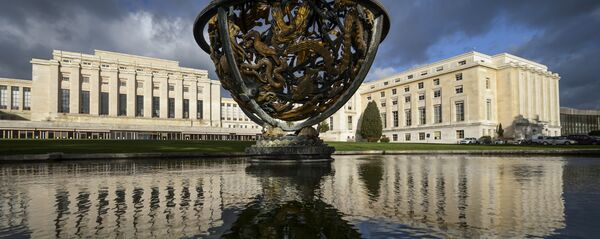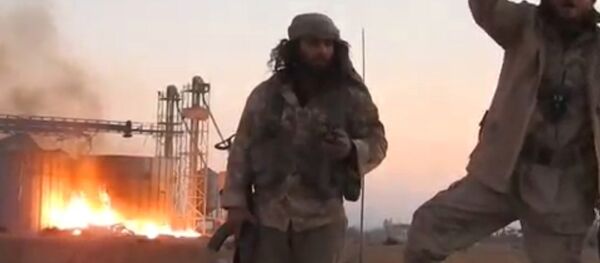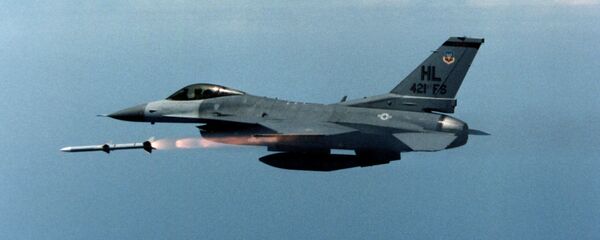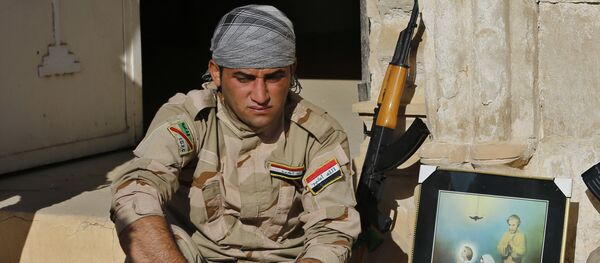Political Track
On the political track, the Syrian settlement has been ploughing through the competing views of the sides to the conflict and the opposition groups, as well as the external actors that stand behind them.
After several false starts in January and February, the proximity intra-Syrian talks resumed in mid-March to outline a common agenda among disparate delegations – the three opposition groups (the Riyadh-backed High Negotiations Committee, Moscow-Cairo group and internal Hmeymim group) and the Syrian government delegation.
However, as soon as the substantive discussions started, Riyadh-backed High Negotiations Committee walked out from the negotiations, citing lack of progress on the ground. Even de Mistura, known for his diplomatic manners, qualified HNC’s departure as an "act of pressure" and "posturing."
The move, apparently, divided the HNC itself into a more moderate and a more radical wings, as the delegation saw some reshuffle afterwards.
Although the composition of the Transitional Governing Body (TGB) was not agreed upon officially, backstage talks about it continued. The Moscow-Cairo opposition group carefully started promoting the idea of appointing five deputies for Syrian President Bashar Assad while nominally leaving him in power. HNC, in turn, continued to insist that "Assad must go."
The Russian side insisted on the need to jointly fight against the Jabhat Fatah al Sham (al-Nusra Front outlawed in Russia) group in Aleppo. The US side claimed that Moscow targeted moderate opposition, while Washington itself was seeking to overthrow the Syrian government. US President Barack Obama said in August he was not sure whether he could trust Russia in Syria.
Russian Foreign Minister Sergei Lavrov and US State Secretary John Kerry tried to restore trust at record-long negotiations in Geneva on September 9. After 15 hours of talks, they worked out a new plan aimed at reducing violence in Syria, which included a new ceasefire starting from September 12. The parties kept documents in secret, but one of the main provisions, which became public through the leaks, envisaged that Moscow and Washington together separate moderate opposition from terror groups.
The two sides, however, could not overcome differences and implement the agreements. Throughout September, the State Department repeatedly threatened to suspend cooperation with Russia on Syria, which finally happened on October 4.
Later in October, the foreign ministers of Russia, the United States, Egypt, Saudi Arabia, Turkey, Iran, Iraq and Jordan met in Lausanne to discuss the Syrian settlement, but failed to make any concrete decisions and just said that the talks were "very constructive."
Soon after the suspension of US-Russian cooperation, France took the initiative. Paris worked out a draft resolution to the Security Council aimed at ending violence in Syria’s northern city of Aleppo. The resolution called for an immediate ceasefire and humanitarian aid access. It proposed the establishment of a no-fly zone over Aleppo, which was bound to be vetoed by Russia.
Russia, in turn, presented an alternative draft resolution to the UN Security Council. Russian Foreign Minister Lavrov reiterated that the resolution must be unambiguous about the necessity of fighting terrorism and separating the moderate opposition in Syria from terrorists.
The initiative to work out a binding document on the Syrian settlement was taken over from France by New Zealand, which introduced a draft resolution, co-sponsored by Egypt and Spain and calling for a minimum 10-days halt of military activities in Aleppo, to the UNSC.
It was also vetoed by Russia and China, with Venezuela voting against and Angola abstaining, on December 6. Russia’s envoy to the UN Vitaly Churkin argued that the draft declaration had been voted on too soon, in violation of the 24-hour rule for reviewing the proposal. Sergei Lavrov said a ceasefire would be used by militants to regroup and get more fighters.
Damascus expressed its gratitude to Moscow and Beijing.
Humanitarian Track
Deplorable humanitarian situation in the country prompted assistance agencies, the United Nations and foreign governments to come up with various initiatives to deliver aid and help civilians in besieged and hard-to-reach areas.
The Russian Defense Ministry set up the Center for reconciliation of opposing sides to plan, monitor and carry out peace restoration operations in Syria. Based at the Hmeymim airbase, it became operational at the end of February.
The Russian Aerospace Forces also played a major role in liberating Palmyra and its historic ruins, which were under the control of Daesh militants (terror group outlawed in Russia) between May 2015 and March 2016. When the city was free from the occupants, the Russian Army began neutralizing the bombs that the terrorists had left behind.
As of March 2016, about 683 tons of humanitarian aid and medicine had been delivered to the Syrian provinces of Hama, Homs, Latakia, Daraa, Deir ez-Zor, Aleppo and Damascus, according to the Russian Defense Ministry.
In June, Russian Defense Minister Sergei Shoigu ordered the Hmeymim airbase command to increase assistance to the Syrian population, especially to those trapped in settlements blocked by terrorists. Russian military has so far kept up a steady stream of aid deliveries.
In September, Russia and Belarus put together a cargo of 2.9 tons, containing food, blankets and infant formula, which were then delivered to an orphanage in Latakia, a port city, south of Aleppo.
At the end of July, Sergei Shoigu announced the launch of a major humanitarian mission in Aleppo. The Syrian army set up three humanitarian corridors granting safe passage to the civilians who wanted to move to the western part of the city and a special corridor for the militants. The Russian Army committed to maintaining hot food stations, water supplies and first aid next to those corridors.
Later on, the Syrian government troops and allied militia with the help of Russian aviation resumed military operations in Aleppo following the premature end of the ceasefire brokered by Russia and the United States.
The operation turned out to be rather effective, and by the end of the year Syrian government forces almost managed to retake eastern part of the province, which had long been under the rebels’ control. The humanitarian situation, however, aggravated, as the fighting had affected thousands of civilians still trapped in the city.
On December 3, Sergei Lavrov said that Moscow was ready to send experts to Geneva as soon as possible to agree with US colleagues on joint actions which would allow all militants without exception to leave eastern Aleppo, and allow non-interrupted humanitarian deliveries. However, there was a reluctance on the US side.
In the wake of the incident, the US Department of State expressed its outrage over the reported attack and said it would reassess cooperation with Russia in Syria, claiming that the incident occurred despite the Syrian army and Russia being aware of the convoy’s destination. The Russian Defense Ministry insisted that Moscow and Damascus were not involved in the incident. Moscow questioned the real US intentions and claimed the attack could have been staged on purpose to create a pretext for ending cooperation with Russia. To puzzle out the situation, the UN set up a special commission to investigate the attack. The inquiry is still ongoing.
Military Track
On the military track, Syrian conflict throughout 2016 saw several ceasefire attempts, which, however, failed to introduce a lasting cessation of hostilities.
The first attempt was agreed upon on February 22. Russia and the United States reached a deal on a cessation of hostilities in Syria, which took effect on February 27. The ceasefire was unanimously endorsed by the UNSC Resolution 2268 and did not apply to terrorist groups operating in the country – Daesh and al-Nusra Front.
The agreement allowed Staffan de Mistura to start intra-Syrian talks in Geneva in March. However, soon after, opposition forces started blaming the government for lack of respect to the ceasefire. The HNC even walked out of the negotiations citing absence of progress on the ground.
In March, Moscow decided to partially withdraw its air group from Syria, where it had been operating since September 2015. Vladimir Putin said the air campaign had largely fulfilled its objectives.
April saw heavy fighting taking place in the city of Aleppo, resulting in airstrikes destroying a hospital and a mosque. Russia, however, still believed that the ceasefire regime was being implemented despite sporadic issues related to actions of Daesh and al-Nusra Front.
In May, Amnesty International reported that chemical weapons could have been used in the predominantly Kurdish Sheikh Maqsoud district in Aleppo.
The second ceasefire attempt was formalized at Lavrov-Kerry record-long talks in Geneva on September 9. The new plan entered into force on September 12. Had it lasted for at least seven days, the United States and Russia would have launched the work of a joint implementation center (JIC) to focus on various practical issues, including the differentiation between terrorists and opposition groups in Syria.
These plans, however, have not been implemented. The ceasefire was undermined as both government forces and the so-called moderate opposition each claimed the other side had violated the truce.
In the beginning of October, a State Department spokesperson said the United States was weighing unilateral military options to address the crisis. However, with the changes in the US administration ongoing since November, these statements are unlikely to come true.
On December 11, Daesh managed to reenter the ancient city of Palmyra after two days of fierce battles. The Syrian Army regrouped on the outskirts of the city. A day later the Syrian Army regained control of almost 100 percent of Aleppo.
The remaining weeks before the end of the year are unlikely to bring any improvements on either political, or humanitarian or military track. Internal Syrian opposition group Hmeymim, however, hopes for a steady progress on the Syrian settlement in the beginning of 2017.
"We hope at the end of this year and at beginning of the next year there will be more steady progress toward a better situation in Syria. But it will take a long time in general," official representative of the group Mais Krydee told Sputnik.
In any case, the Syrian conflict is bond to remain the key determinant of the foreign policies of regional and global powers in 2017.











